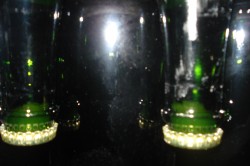
Smaller family run cava producers are abound in the Penedès wine region and most conserve an artisan methodology in the elaboration of its cava products. Elaborating wines with an artisan perspective means disregarding modern methodology, and thus means using the traditional methods; it also signifies having meticulous care when selecting the first must, or the run-off, in each single press.
Ferré i Catasús 
The process begins in the vineyards of the Penedès Wine Region, close to the Catalonian capital Barcelona, Spain, where the vines are slow to ripen. The grapes (usually local varieties like Xarello, Macabeo, and Parellada) are harvested in September and blended into the vin de cuvee, the base wine.
During the primary fermentation, the grapes ferment like conventional wine. It is the second fermentation that distinguishes sparkling wine production, giving Cava its characteristic “bubbles.”
The secondary fermentation uses the traditional “Champagne method.” Fresh yeast and sugar are introduced to the base cuvee, triggering the fermentation process inside the bottle. “Time on the yeast” adds complexity to the wine as the yeast and sugar break down. This aging process lasts for at least 9 months and creates a huge amount of pressure (about 5.5 atmosphere) inside the bottle.
During the “remuage” or “riddling” process, the bottles are periodically turned so that the residue from the yeast collects in the neck of the bottle. The bottles are kept nearly upside down during this process. Next, the neck of the upside down bottle is frozen, forcing the sediment to form a solid cube at the very top of the neck.

The bottle is corked immediately after the disgorgement to maintain the dissolved carbon dioxide gas and keep the wine’s bubble. The Cava is now ready to be sold and drank as quickly as possible, as Cava does not improve with age.
At Ferré i Catasús they make 3 cavas: Brut Nature (Xarello, Macabeo, and Parellada) , Brut (Xarello, Macabeo, and Parellada) and Brut Rosado (Pinot Noir). Our favourite was the Brut Rosado!
Kerrie Lopez, Travel Writer for Wine Pleasures
Video: Wine maker, Txema at Ferré i Catasús talks cava. We also asked him for his view on the seemingly american habit of ageing cava at home – does it improve with time or does it decline? Do you store your cava at home thinking it will get better over time?
0 Comments